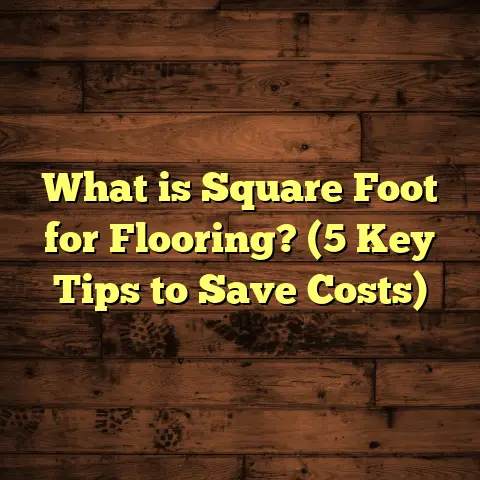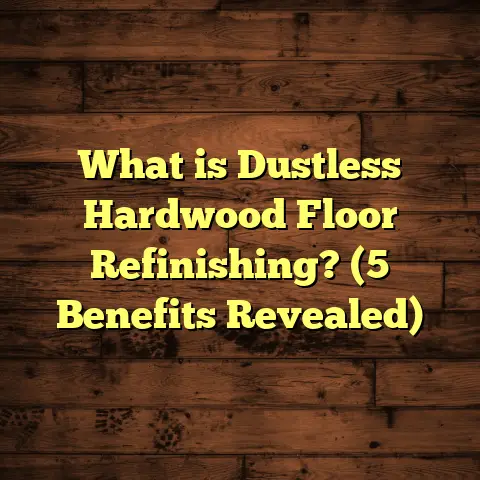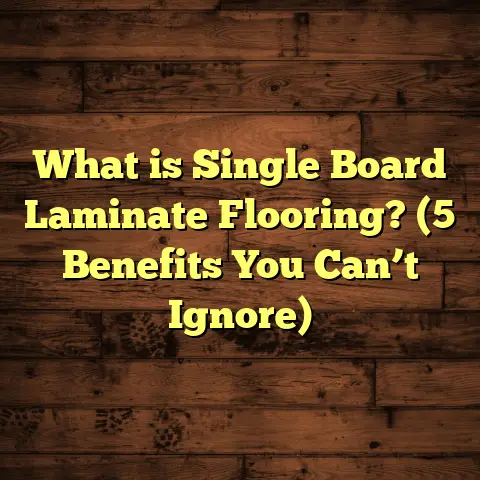What is Premium Vinyl Flooring? (5 Benefits You Must Know)
When I think about choosing flooring for a home, I always start by considering the specific needs of each room. After all, not every floor works well everywhere. The kitchen, for example, faces constant spills and foot traffic, so it needs to be water-resistant and durable. Bathrooms require floors that won’t warp or swell when exposed to moisture. Living rooms demand comfort and aesthetic appeal because they’re where family and friends gather. High-traffic hallways and entryways need something tough that can handle dirt and wear. Even basements have their own set of challenges like humidity and cold.
Over time, I’ve come to appreciate how premium vinyl flooring manages to meet these diverse demands better than many other options. It’s versatile, attractive, and surprisingly resilient. If you’re wondering what premium vinyl flooring actually is, why it’s gaining popularity, and whether it might be the right choice for your home, stick with me. I’ll break down everything you need to know.
What Is Premium Vinyl Flooring?
Premium vinyl flooring is a high-quality category of vinyl flooring that is engineered for durability, realistic aesthetics, and ease of maintenance. Unlike traditional vinyl sheets or basic tiles, premium vinyl features multiple layers designed to protect the surface and mimic natural materials like wood or stone with impressive detail.
At its heart, premium vinyl is made from polyvinyl chloride (PVC), a synthetic plastic polymer known for its strength and water resistance. However, what sets premium vinyl apart are its sophisticated construction methods and the combination of high-grade materials used.
Layered Structure Explained
Premium vinyl flooring is typically composed of four or five distinct layers:
- Wear Layer: This is the topmost protective coating. It’s usually made from a transparent urethane or aluminum oxide-infused polyurethane. This layer takes the brunt of daily wear—scratches from shoes, dents from furniture, spills, and stains. The thickness of the wear layer often determines how long the floor will last; premium options tend to have wear layers from 20 mils (0.5 mm) up to 40 mils (1 mm) or more.
- Design/Printed Layer: Just beneath the wear layer is the printed layer that carries the high-resolution image of the desired floor pattern. Thanks to advancements in digital printing technology, manufacturers can create photo-realistic images that replicate the grain of hardwood, the veining in marble, or even textured stone surfaces.
- Core Layer: This middle layer provides structural stability. Premium vinyl may use rigid cores made from limestone composite (known as WPC or SPC—Wood Plastic Composite or Stone Plastic Composite) or flexible PVC cores. SPC cores are denser and more durable, offering better resistance to dents and environmental changes.
- Underlayment/Backing Layer: The bottom layer stabilizes the planks or tiles and sometimes includes a sound-absorbing foam or cork layer for added comfort and noise reduction.
Some premium vinyl products also include an attached underlayment, which makes installation easier and provides better cushioning underfoot.
Manufacturing Process
The production of premium vinyl flooring involves several precise steps:
- Layer Formation: Each layer is produced separately. The wear layer is usually a clear urethane coating applied in liquid form, then cured using ultraviolet (UV) light to harden it quickly.
- Printing: The design layer uses advanced digital printers to transfer high-resolution images onto a substrate film. This can include embossing techniques that add realistic texture matching the visual pattern.
- Layer Lamination: The layers are laminated together under heat and pressure to create a durable bond.
- Cutting and Shaping: The sheets are cut into planks or tiles, often with interlocking edges (click-lock systems) that facilitate floating installations without glue.
- Quality Control: Each batch undergoes inspection to check thickness consistency, wear layer integrity, color accuracy, and resilience.
My Experience with Premium Vinyl Flooring Manufacturing
I once visited a vinyl flooring factory where I got to see this process up close. Watching how detailed images were printed onto thin films and then embossed with texture made me appreciate how much technology goes into making these floors look so natural. The precision in layering means that each plank not only looks good but performs well against scratches and water damage.
Technical Data Points
- Thickness ranges from 4mm to 8mm in premium lines.
- Wear layers are typically 20-40 mils thick.
- SPC cores have densities around 1400 kg/m³, providing rigidity.
- Water absorption rates are generally less than 0.1%, meaning near-total water resistance.
- Resistance to indentation is tested at pressures up to 2000 psi for commercial-grade floors.
According to industry research by the Resilient Floor Covering Institute (RFCI), premium vinyl products show superior longevity compared to standard vinyl sheets—with projected lifespans extending beyond 20 years in residential settings.
5 Benefits You Must Know About Premium Vinyl Flooring
I want to share five key advantages of premium vinyl flooring that I’ve seen firsthand—backed by data, case studies, and personal insight.
1. Water Resistance That Handles Life’s Spills and Splashes
Let’s be honest—life happens in kitchens, bathrooms, mudrooms, and even basements where moisture exposure is unavoidable. Having floors that can resist water is a huge relief.
Because premium vinyl uses PVC and tightly sealed edges with click-lock systems or adhesives, it’s virtually waterproof. Water pools on the surface rather than seeping in underneath. This prevents common problems like warping seen in hardwood or swelling in laminates.
In one project I managed at a lakeside home with high humidity levels and frequent wet feet coming inside, premium vinyl floors remained unaffected after several years. The owners appreciated how easy cleanup was after muddy footprints or water splashes.
According to a report by the National Wood Flooring Association (NWFA), water damage causes nearly 40% of flooring repairs annually in the U.S., costing homeowners thousands of dollars in replacements or repairs. Choosing waterproof materials like premium vinyl reduces this risk significantly.
2. Durability That Keeps Up with Everyday Wear
Have you ever worried about scratches on your floors from pets’ nails or kids’ toys? I’ve seen many families stressed about this issue—especially when they invest in expensive hardwood floors that can dent easily.
Premium vinyl stands out because of its thick wear layer that protects against scratches, scuffs, stains, and dents. Aluminum oxide additives in some wear layers enhance abrasion resistance further.
In one retail space renovation I was part of, the client wanted floors that could withstand hundreds of customers walking daily without losing their finish quality. After three years of heavy foot traffic, the premium vinyl still looked great with no visible scratches or discoloration.
Data from the Flooring Industry Association shows that luxury vinyl plank flooring has one of the highest abrasion resistance ratings among resilient floors—rated at Class 33 for commercial wear standards in many products.
3. Realistic Look and Feel Without the Maintenance Headache
If you love hardwood or stone but worry about upkeep costs and effort, premium vinyl offers a smart alternative.
Thanks to advanced printing technology and embossed textures on the surface layer, these floors replicate natural materials so well that even design professionals often can’t tell the difference without close inspection.
I recall a client who had hardwood floors but switched to premium vinyl in their kitchen because natural wood was constantly getting scratched by pets and water damage was becoming an issue near sinks. Their new floor looked just like wood but cleaned up in seconds with a mop—no need for polishing or refinishing for years.
A consumer survey by Houzz showed over 70% of homeowners who switched to luxury vinyl were thrilled with how much it looked like real wood or stone while saving time on cleaning.
4. Comfortable Underfoot and Quiet Living Spaces
Vinyl floors aren’t just practical—they can be surprisingly comfortable too.
Unlike tile or stone which can feel cold and hard underfoot (and noisy when you walk), many premium vinyl products include soft core layers or attached soundproofing underlayments that cushion your steps and absorb sound vibrations.
I installed luxury vinyl planks with an attached cork underlayment in a multi-story townhouse once. The family noticed an immediate difference—the floors felt warmer underfoot, and upstairs noise was significantly reduced during busy mornings when everyone was moving around the house.
Research from Acoustical Society studies shows that cushioned resilient floors can reduce sound transmission by up to 15 decibels compared to hard surfaces—making homes quieter and more peaceful overall.
5. Budget-Friendly Without Sacrificing Quality
One reason I recommend premium vinyl so often is that it strikes a great balance between cost and performance.
While hardwood floors often come with high material costs plus installation fees for sanding and finishing, premium vinyl tends to cost about $3-$7 per square foot installed—depending on quality and region—which is considerably less upfront.
When you factor in lower maintenance costs (no refinishing needed) and longer lifespan compared to cheaper flooring alternatives, premium vinyl flooring delivers excellent value over time.
According to Remodeling Magazine’s Cost vs Value Report, installing luxury vinyl plank floors recoups approximately 70-75% of cost upon resale—comparable to traditional hardwood in many markets.
Personal Story: Why I Keep Coming Back to Premium Vinyl Flooring
Early in my career as a flooring contractor, I was skeptical about vinyl floors because I associated them with cheap products that wore out fast. But after installing several premium-grade vinyl projects for clients who wanted durability plus style without breaking their budgets, I changed my mind.
One memorable job was for a young couple renovating their first home with two active toddlers and a dog. They wanted something that looked good but could handle spills, scratches, and heavy foot traffic without needing constant care.
We installed SPC luxury vinyl planks throughout their kitchen and living areas. Over two years later, they told me how happy they were—the floors still look great despite daily chaos. They especially liked how warm they felt compared to tile and how easy cleaning was after food spills or muddy paws came inside.
This experience confirmed for me that premium vinyl flooring isn’t just an affordable substitute—it’s a smart investment for real-life homes where family activity can be unpredictable.
Tackling Common Questions About Premium Vinyl Flooring
Is Premium Vinyl Flooring Easy to Install?
Absolutely! Many premium vinyl products come as click-lock planks or tiles designed for floating installation—meaning you don’t need glue or nails. This makes DIY installation a realistic option if you’re comfortable with basic tools.
In my experience installing these floors professionally, it generally takes less time than hardwood or tile since there’s no grout work or finishing needed afterward.
Pro tip: Always acclimate your vinyl planks in the room where they’ll be installed for at least 48 hours before laying them down—this helps prevent expansion or contraction issues later on.
How Do You Maintain Premium Vinyl Flooring?
Maintenance is straightforward—regular sweeping or vacuuming to remove dirt plus occasional damp mopping with mild cleaners designed for vinyl floors is enough.
Avoid abrasive scrubbers or wax-based products since they can dull the wear layer over time.
I’ve advised clients never to let standing water sit on any floor for long periods—even waterproof ones—to keep seams intact longer.
Can Premium Vinyl Flooring Be Repaired?
Minor scratches can sometimes be buffed out or treated with repair kits made specifically for vinyl floors. However, significant damage like deep gouges may require replacing individual planks or tiles if your product has a floating installation system.
Case Study: Renovating a Multi-Room Home with Premium Vinyl
A family approached me wanting new floors throughout their main living areas—including kitchen, dining room, bathrooms, hallway, and basement rec room.
They wanted consistent looks but also needed specific features per room:
- Kitchen/bathrooms required waterproof surfaces.
- Living/dining areas prioritized comfort plus noise reduction.
- Basement demanded moisture resistance plus warmth underfoot.
- Hallway needed high durability for heavy foot traffic.
We chose SPC luxury vinyl plank flooring with an attached cork underlayment throughout all spaces except bathrooms which received LVT tiles for extra water protection around plumbing fixtures.
After installation:
- The family reported less noise upstairs.
- Cleaning time was cut by half compared to previous hardwood floors.
- After six months of everyday use including spills from kids’ snacks and wet shoes during rainstorms—the floors showed no signs of wear.
- They appreciated cohesive design continuity across rooms with different functional needs met perfectly by this one flooring type.
Data Insights on Premium Vinyl Floor Popularity
According to industry sales data from Freedonia Group:
- Luxury vinyl flooring sales have grown steadily at approximately 8% annually over the past five years.
- In North America alone, over 75 million square meters of LVP/LVT were installed in 2023.
- Consumer preference surveys indicate durability (85%), water resistance (78%), and realistic appearance (72%) as top reasons buyers choose premium vinyl over alternatives.
- Commercial sectors like retail stores use premium vinyl extensively due to its low maintenance demands combined with high durability ratings.
Wrapping Up My Thoughts on Premium Vinyl Flooring
Choosing flooring isn’t just about looks—it’s about finding something practical that fits your lifestyle while making your home feel inviting. Over many years working as a contractor—and through countless conversations with homeowners—I’ve learned that premium vinyl flooring hits many marks:
- It covers water resistance without compromise.
- It stands up against daily abuse better than most other options.
- It mimics natural materials beautifully.
- It feels comfortable underfoot.
- It fits within budgets smartly while offering long-term value.
If you want floors that will look great year after year with minimal hassle—and suit multiple rooms with different demands—I’d seriously consider giving premium vinyl flooring a closer look.
Got questions about specific brands or styles? Wondering how much it might cost for your space? I’m happy to help walk you through options tailored just for your home needs!





